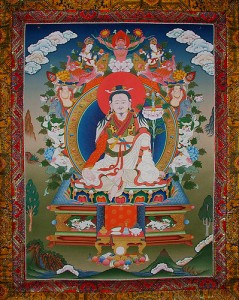The following is respectfully quoted from “The Jewel Ornament of Liberation” by Gampopa as translated by Khenpo Konchog Gyaltsen Rinpoche:
Homage to the Three Jewels
The Three jewels of Buddha, Dharma, and Sangha are the rarest and most sublime objects in the universe. Therefore, from now until he attains enlightenment, the author of the treatise pays heartfelt respect to them in thought, word, and deed, his aim being to protect beings who wander in samsara, afflicted by many evils.
The Three Jewels may be explained according to their essential characteristics, the etymology of the Tibetan term, their various subsidiary aspects, and an explanation of the Sanskrit term. Essentially, buddhahood is the perfection of all the qualities of “elimination” and ‘realization.” According to the Tibetan expression snags rgyas, a Buddha is one who has awoken (sangs) from the deep sleep of ignorance and whose mind has blossomed (rgyas) like a lotus flower with the knowledge of all things. Buddhahood in turn has three aspects: (a) the kayas, which act like containers for (b) the wisdom contained therein, together with (c) the enlightened activities that flow from these. Finally, the Sanskrit word Buddha means “one who perfectly comprehends,” one whose mind encompasses all objects of cognition and thoroughly understands them.
Essentially, the Dharma is characterized by the elimination of one or both of the twin veils of defiled emotion and cognitive obscurations, or the means to this elimination. The Tibetan word chos is so used because the Dharma purges (‘chos) the mind of negative emotion in the same way that medicine cures someone who is sick. As to its aspects, the Dharma may be classified in two ways: one the one hand, as the Dharma of transmission and the Dharma of realization, and on the other, as the third and forth of the four noble truths, the truth of cessation and the truth of the path. In Sanskrit, the word dharma means “to hold.” in other words, the Dharma is what holds beings to the perfect path and keeps them from the ways of samsara and the lower realms.
Essentially, the Jewel of the Sangha is characterized by the possession of two qualities: knowledge of the truth and freedom from defilements. The Tibetan term dge ‘dun refers to those who have a keen interest (‘dun) in the path of perfect virtue (dge). Such practitioners may be divided into those belonging to the Hinayana Sangha of Shravakas and Pratyekabuddhas, and those belonging to the Mahayana Sangha of Bodhisattvas. The Sanskrit word has the meaning of “assembly” and refers to the community of those who are not distracted from the path by anyone, even gods.
The words “I prostrate” express a perfect salutation to the Three Jewels. This may be made on three levels: first, by realizing the view; then, by proficiency in meditation; and finally, by an act of devout veneration.
The “Precious Three” of the root verse is a reference to the Three Jewels and indicates that the Body, Speech, Mind, Qualities, and Activities of the Buddha are renowned throughout the three worlds. Jigme Lingpa gives an elegant illustration of this by referring to the story of how the Buddha once sent a message to the princess Vine-of-Pearls in the form of a picture of himself together with some verses, printed on a piece of white cloth. When the girl saw the image, the joy she experienced was so intense that it was like a samadhi devoid of even the subtlest kind of discursive thought. And as she reflected on the meaning of the message, the one hundred and twelve obscurations that are hinderances to liberation, and which are discarded on the path of seeing, fell away. The root text compares these obscurations to the deceitful faces of Mara’s daughters, which are like lilies of the night, opening in darkness and blasted by the sun of wisdom cultivated on the path of seeing. As a result, Vine-of-Pearls was prepared for the dissipation of what is to be eliminated on the path of meditation. And all this came about through the power of the Buddha’s compassion. All such religious stories that tell of the effects of the Three Jewels are worthy of universal consideration, for they powerfully counteract the mental distraction and defiled emotions that are the very nature of samsaric existence.
Commitment to Compose the Text
The boundless collections of sutra and tantra teachings were propounded by the Buddha, master of the supreme wisdom of omniscience, who set them forth by means of the five excellences. His followers, the noble Bodhisattvas, composed commentaries beautiful in word and meaning, on the basis of the system of five major elements, compiling them according to the “fourfold interrelated purpose.” These scriptures and commentaries are vast and profound as a great ocean; they are a veritable treasure of purifying waters. Thanks to them the Doctrine of the Conqueror has remained for a long time. Maitreya has said:
All Dharma is contained in Word and Commentary,
The perfectly expressed and its interpretation.
These two ensure that Shakyamuni’s Doctrine
Will remain for long within the world.











